Where Is It From? | The Responsibility | Vet Care | Resources

People come in to pet ownership for any number of reasons including: companionship, a general love for animals, a driving curiosity, and sometimes, some animals just end up in the hands of an unsuspecting person. All of these are worthy reasoning for being a pet owner but these alone don’t mean one should be one. The reason alone for wanting or owning a pet is the easy the part; that’s no doubt. It’s everything that comes after that should make one pause and think.
Let’s take you through that thought process to help determine if you are ready to be a responsible pet owner…
Pet Ownership Facts:
Millions of households that own at least one pet
Where Is the Pet From?
Jump to Section

According to the Humane Society of the United States4:
| Where From? | Dog | Cats |
| Adoption | 37% | 46% |
| Pet Store | 4% | 2% |
| Gifted | 20% | 28% |
| Breeders | 34% | 3% |
| Strays | 6% | 27% |
The most common ways people get pets include: through the purchase from a pet store or breeder; from an animal shelter or adoption center; being gifted one from another person; or finding one in nature. One of these methods is an excellent option, one is a big no-no and the others are completely acceptable under the right circumstances.
The Good
- Adopting a rescue from an animal shelter
- Purchasing one from a pet store
- Being gifted one you can properly care for
The Bad
- Buying from a pet store that uses bad practices
- Purchasing through an unknown breeder
- Being gifted one you are not prepared for
The Just NO
- Taking an animal from its natural habitat
- Buying a sick pet from the store
- Getting an animal from a “mill”
- Being gifted one you will never be ready for
Taking in a stray dog or cat from the wild could be considered either a good or bad idea. Though these animals are not technically in their natural habitat, you can find information on them in the section, Taking Animals from Nature.
Pet Stores
The pet industry is big business – a billion dollar industry – $58.04 billion to be precise. $2.15 billion of that was spent on the purchase of living animals5. Most people are familiar with the two big players in the game, PetSmart and Petco, but there are many other smaller retailers out there as well. PetSmart and Petco routinely carry healthy animals that are strictly obtained through reputable breeders. However, there’s a chance that other pet stores don’t and instead use bad practices, resulting in unhealthy animals.
That’s not to say all or even most small mom-and-pop pet stores use bad practices. It’s best to determine this on a case-by-case basis. The following information should help you make the decision to use or boycott any given pet shop.
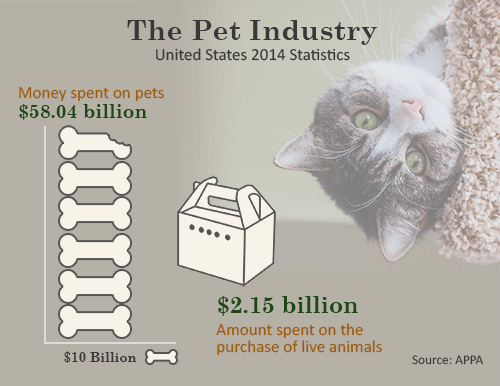

You should be on the look out for the warning signs of poor living conditions. Here is a non-exhaustive list of things to look for before purchasing:
- Any dead or sickly looking animals is a clear red flag (most common among fish)
- Animals should have enrichment activities or access to toys
- Animal display areas should have good ventilation and exhaust systems
- Display areas should be neat and clean without an accumulation of waste
- Housing cages should not be rusty or damaged
- Waste of any sort from stacked cages/tanks should not fall onto those below
- The staff is generally knowledgeable about the pets they sell
- The store doesn’t sell animals to children
Dogs and Cats from Pet Stores
If you can, look to pet stores that only sell shelter animals. Petsmart does not sell dogs or cats but through PetSmart Charities®, it helps adopt out homeless pets. To date the charity states it has helped find homes for 6 million pets and more than a 1000 daily.6 Likewise, Petco doesn’t sell cats or dogs either. The Petco Foundation works with community partners to help find homes for thousands of homeless pets a week.7 59 other cities and counties have followed suit by passing legislation to only allow pet stores in their respective areas to sell shelter cats and dogs.8
Animal Shelters
There are approximately 5 million pets that go into over 5000 animal shelters and rescue centers around the United States every year. More than half of these animals never make it back out. To be more accurate, 60% of all dogs and 70% of all cats don’t get adopted.9 For this very reason, you should first look to adopt your next pet from a rescue shelter.
It’s not just dog and cats that you can find at a shelter; you can also sometimes find rabbits, guinea pigs, birds, turtles or other small animals. It’s best to call around to check if your local center has what you are looking for.
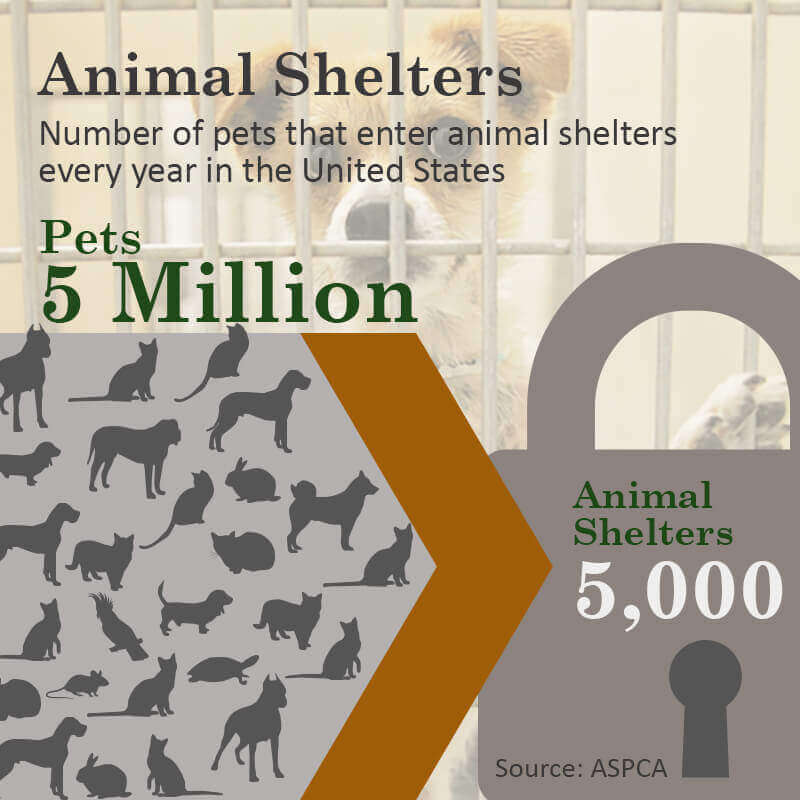
Dog Breeds Most Available at Animal Shelters
Animal Breeders
It isn’t recommended to go through a breeder for your next pet but it’s totally understandable. Not all breeders use the same bad practices that “mills” do and many breeders are likely above board and properly licensed. However, with so many shelter pets in need of a home, all breeders regardless of their love and care, don’t work to help the homeless pet population.
People that go through breeders are usually looking for a purebred or a specific mix of breeds. The demand for these animals is undeniable. Purebreds are limited in quantity and the mixed breeds are often engineered to look unique or downright adorable. The high demand and limited quantity of these animals can make them rather expensive. The American Kennel Club lists the most popular dog breeds.
The starting cost for some of the most expensive animal breeds:
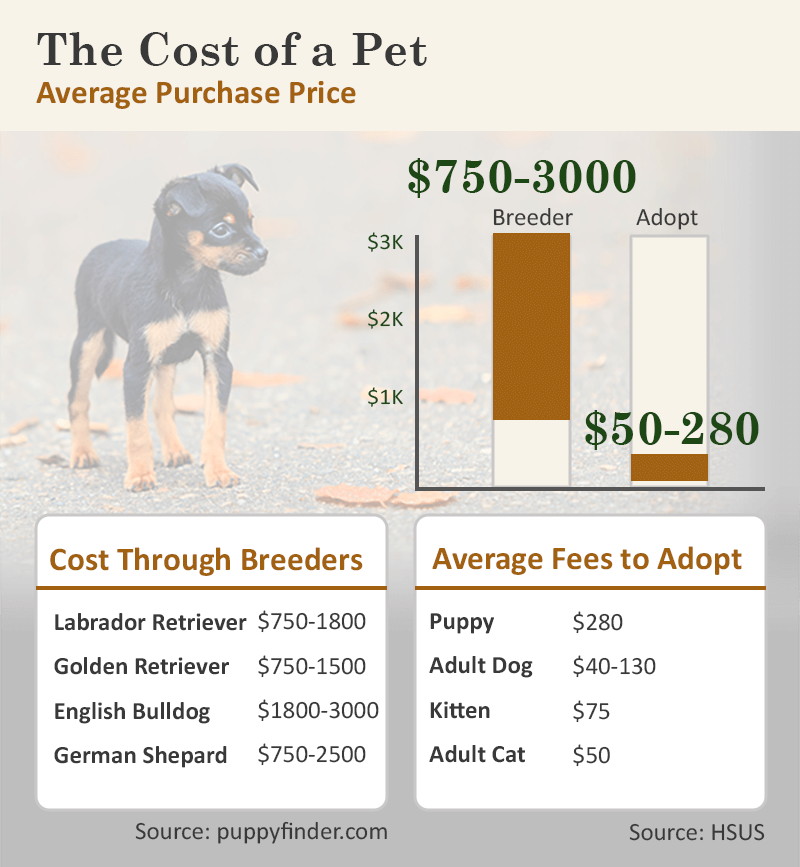
Dogs10
- Canadian Eskimo: $6,000
- Alsatian: $6,500
- Samoyed: $6,500
- Rottweiler: $7,000
- Lowchen: $7,000
Cats11
- Peterbald: $1,700
- Persian: $3,000
- Bengal: $3,000
- Savannah: $25,000
- Ashera: $75,000
Other Notables
- A Tibetan mastiff named “Big Splash” reportedly sold for: $1.5 million12
- Tapit, a stallion earns per stud fee: $300,00013
- Pastel Butter Stripe Ball Python: $7,500
- Hyacinth Macaw: $11,000
- Palm Cockatoo: $15,99914
If you do purchase from a breeder, make sure it’s a licensed one that will provide you with all the appropriate paperwork proving your new pet’s breed.
Avoid “Puppy Mills”
There are 10,000 licensed puppy mills in the United States. Fewer than 3000 of these are regulated by the U.S. Department of Agriculture. An estimated 2.12 million puppies are sold each year through the combined sales of both licensed and unlicensed mills.15
What gets a breeder the designation of being a “mill” is when they care more about their profits than the well-being of the animals they breed. Some of the signs that a breeder is running a puppy mill include:
- Animals that are malnourished and underfed with a lack of food and water dishes available
- Animals with open wounds, untreated injuries, disease or illness and have little to no access to vet care.
- Living conditions that are unsanitary, cramped, overcrowded, dark and gloomy.
- A larger than normal amount of animals being euthanized due to lack of proper care.
- Mother dogs, “brood bitches” that are pregnant all the time and their puppies are taken from them far too young
- In general, puppy mills fail to meet the physical and psychological needs of the animals they keep.
The Humane Society of The United States (HSUS) routinely investigates these mills and provides reports on their findings. The recent report shows numbers of violations from mills in 16 different states. Read their most recent report.
Some puppy mills try to get around all this bad publicity by going to the Internet, creating fancy websites and selling puppies online. In doing so, they can hide the unhealthy living conditions of their breeding facilities. To make matters worse, many unsuspecting buyers receive puppies that are not what they ordered. Some of these puppies are simply the wrong puppy with different markings than what was advertised. Far worse however, some of then arrive in bad shape with serious health issues. There are tragic stories of $1500+ vet bills and puppies having to be euthanized because of an issues that was not treated back at the mill.
For this reason you should avoid buying a puppy online. If you insist on purchasing a puppy from a breeder, you need to meet with them. Go see the living conditions and ask a lot of questions about their operation. It’s also wise to look up user reviews of potential breeders to see how healthy all the dogs they sell are.
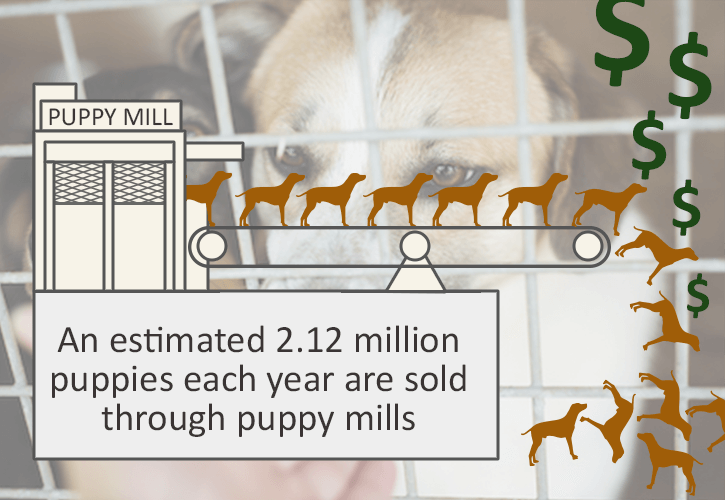
Animals in Nature
Shorter Lifespan
Animals in their natural habitat are right where they need to be. Animals that are born in the wild and know nothing but freedom do not adjust well to captivity. Often these animals will begin to show signs of being psychologically unhealthy. Most of these animals will end up having shorter lifespans than if they were left where they were found.
Spread of Disease
Wild animals collected from nature can contain diseases or parasites. If one of these is introduced into a household, it could lead any existing pets becoming infected. There are also several diseases that can be transmitted from animal to human.
- See a comprehensive list of animal transmitted diseases.
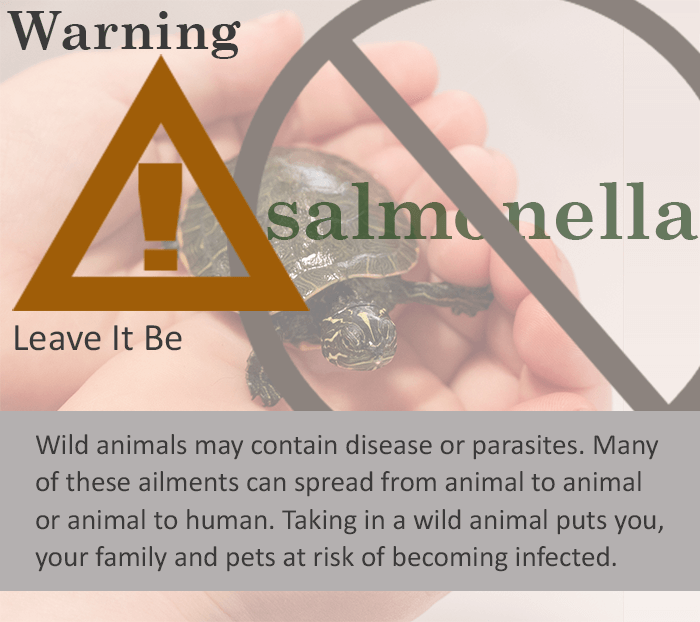
Tips on What to Do
- If an animal is hurt or a baby appears to be orphaned, call your local animal control or a rescue organization.
- Do not touch these animals since injured animals are likely to be aggressive in defending against what they feel is a threat
- Observe wild animals at a safe distance to limit the chance of injury of the wild animals, humans or pets.
- Keep pets away from wild animals to avoid the spread of illness or injury.
- If an animal appears to be a lost pet, call the local animal control on instruction on what to do next.16
Taking in Strays
Stray cats and dogs are a big concern for many nations. According the World Health Organization there are an estimated 200 million stray dogs worldwide.17 Similarly, according the ASPCA there are an estimated 70 million stray cats just in the United States alone.18 These numbers are understandable when you consider that less than 10% of strays that enter the animal shelters in the US are spayed or neutered and that female cats and dogs tend to have litters of 2-6 babies.19
Lost Strays
Knowing the status of an animal you are considering taking in should weigh heavily on whether you should or not. Many animals you come across might just be lost or an on the loose pet. Nearly 649,000 pets in shelters that are strays are in fact returned to their owners (542,000 dogs and 100,000 cats).20 In many states there are laws in place to give these pets a chance to be claimed by their owners by requiring a waiting period before allowing for them to be adopted out. Even if you really want to keep a lost pet, you owe it to the pet’s owners to help find its way home. Only after the required time has passed, should you consider adopting the pet.

Feral Animals
Since many strays are not spayed or neutered there are a lot of dogs and cats that live their entire lives without having close interaction with humans. These animals are referred to as being feral or free-ranging and are not well-suited as pets. Newborn litters of feral cats and dogs can however adjust to being around humans if it’s done at a young enough age; around 4 to 6 weeks of age. Kittens older than that can still be tamed but the older they get the harder it will be.
Spay and Neuter
Free and low-cost spay and neuter programs help keep shelter numbers down by 30-60%21. There are even catch and release programs that works to catch feral strays, spay and neuter them and then release them.
Surprise, Have a Pet
Pets are gifted to individuals in so many ways and for so many reasons. Kittens or puppies can be given as birthdays, Christmas or even Valentines Day gifts. During the Easter holiday baby chickens and bunnies are given as gifts and on Halloween black cats might be sought after. Even the smallest of pets can be gifted such as a goldfish won at a carnival. It’s usually the thought that counts but what really counts, is the thought of what it will require the gifted to be able to properly care for said pet.
Failing to understand the requirements of pet ownership in itself is another reason people are handed pets they otherwise never would plan to get. Pet ownership often starts on a high, with an over abundance of well intentions and an overall excitement of a new member of the family. Those feelings can begin to sour though as the realities of pet ownership are realized. Some pets just require a bigger commitment than some people can handle. Pets of this nature need training, daily feeding, routine health checks and enrichment activities. People overwhelmed by these things might turn to friends or family to pass along ownership.

Questions to Answer
If you can truthfully answer yes to these questions you are likely ready to own a new pet.
- Do you have the time and patience required to keep this pet happy and healthy?
- Does your home provide the physical space needed for this pet to live comfortably?
- Do you have the resources to obtain the needed supplies for proper care?
- Can you provide this pet with veterinarian care for routine or emergency visits?
If you are unsure of the answers to these, the following sections on responsibility and vet care are provided to help with that.
Are You Prepared for the Responsibility
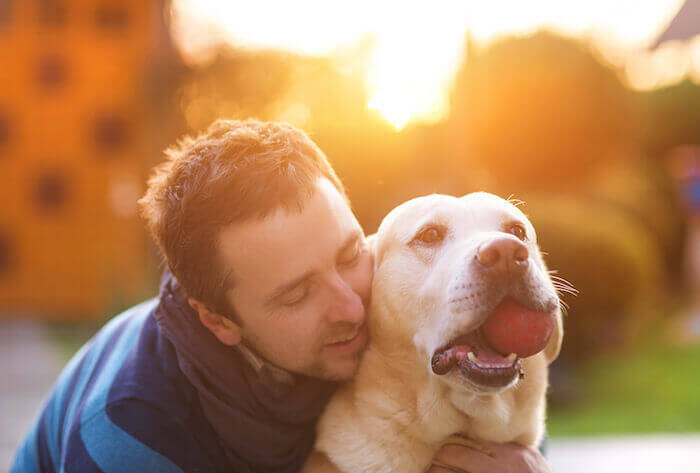
Annual Cost
Being a responsible pet owner includes being able to provide your pets with the supplies and care they need. There is no doubt a cost associated in doing so.
Here are the average yearly costs for owning some of the most common pets.22
- Medium Dog: $545
- Cat: $500
- Rabbit: $675
- Guinea Pig: $565
- Cockatoo: $1035
- Small Bird: $95
- Fish: $135
Advice for Parents
Let’s get a puppy!?
Owning a puppy is a full time job. It requires time, energy, routine, and repetition in order to train them. If you have children, this can be a daunting challenge considering they likely take up most of your time. This is completely expected and so it is important to determine if you can logistically make owning a puppy – a happy, healthy, well-adjusted puppy a reality.
Hour to Hour:If you have a dog that you don’t trust roaming freely around your home while you are away, crating is a good solution. You can also gate-off a small area or use a bathroom as a kennel. This will minimize the damage they can create will you are away. Obviously training your dog not to destroy the furniture or get into the trash is the ideal solution, but it takes time to teach this.
With that said, do not crate a dog for long stretches at a time. This is especially the case for a puppy that has not learned how to hold its bladder. The maximum amount of time depends on the age of the puppy. WebMd recommends the following maximum amount of time to be crated in one sitting based on a puppy’s age:
- 2 months: Up to an hour
- 3 months: Up to 3 hours
- 4 months: up to 4 hours
- 4+ months: up to 5 hours
In the case of crating a puppy overnight, you can expect a puppy to sleep throughout the night in most cases but they will likely wake up pretty early in the am hours needing to use the bathroom. While ignoring a puppy’s cry is a training strategy in crate training, take note of the time and learn to know when a cry is about needing to use the bathroom and not just a cry from separation anxiety. In the case of the later, you can reduce that by crating your puppy in your bedroom so it can see you.Day to Day:Unless you work from home or you and your partner have different work schedules, you will likely need to leave your puppy unattended for 6+ hours at a time. In these cases, you should avoid crating. Instead use the gate or closed off room method. An even better option is to get some help. There are dog walkers for hire that will break up the alone time. There are even doggy daycares that you can drop off your puppy on your way to work and then pick up on your way home. Daycares are a great option if you can afford them.
The benefits of a doggy daycare include:
- Your puppy will get all its daily exercise needs and then some.
- Your puppy will learn how to play and socialize with other dogs.
- Your puppy still might separation anxiety but might feel some relieve by having other loving humans around.
The best daycares include those that can separate dogs by size, have live video feeds of the play area that you can monitor remotely, and provide report cards at the end of the day of how your puppy did.
Month to Month:
When a family vacation comes up, you will need to determine what to do with your puppy or dog at this point. If you can’t or don’t want to bring your dog with you on vacation, you will need to find a long-term solution for their care. There are two basic solutions for this. Having friends or extended family care for your dog while you are away is a practical solution. There are too many reasons to list all of them but this is the best option by far.
The main reasons include:
- Lowest cost solution
- Familiarity for puppy (eases anxiety)
- Trust that nothing bad will happen
- An overall peace of mind.
The other option is to board your dog. Many of the doggy daycares offer extended length stays. During the day you dog will play just like they would do while in daycare. At night, your dog(s) are placed in their own space for overnight sleeping. If you choose this option, make sure you vet them and explore your options. It’s more than just the cost to board but the quality of care. Ask for recommendations from friends and family, read reviews and go visit the facilities you are considering.
Further Reading:Dogs Coexisting with Small Children
The Need for Finding a Veterinarian
It’s understandable that most pet owners will attempt to diagnose and treat their pets’ ailments first before taking them to the vet. Some issues are indeed easy to treat but others are little more complicated.
Just like humans, pets of all types require routine checkups for preventative care – and just like humans, pets can get sick or injured to the point that they require medical attention. Veterinarians fill this need. These doctors have the training to diagnose and treat illnesses and health complications. They can prescribe medications, antibiotics and even carry out medical procedures or operate when needed.
It’s important to know when a vet is needed:
- Open cuts and wounds that don’t stop bleeding
- Limping caused by internal injuries or broken bones
- Swallowing of poisonous substances or foreign object
- Allergic reactions that cause respiratory problems, swelling or rashes
- Hypothermia or heat stroke
- Trauma to the nose, ears, or eyes
- Noticeable fur loss with no clear cause
- Bites from animals such as poisonous snakes, scorpions, or spiders
- Excessive diarrhea or vomiting
- Blocked airways or problems breathing
- Lethargy, exhaustion, or loss of consciousness
- Signs of any other abnormal behavior or injuries
See this poll by AP-Petside.com on what pet owners pay per visit.
Top Reasons for Vet Visits23
Dogs
- Skin Allergies
- Ear Infection
- Non-cancerous Skin Mass
- Skin Infection
- Arthritis
Cats
- Bladder or Urinary Tract Disease
- Periodontitis/Dental Disease
- Chronic Kidney Disease
- Excessive Thyroid Hormone
- Upset Stomach/Vomiting
It’s important to find your vet before you need one.
Vaccinations
For starters, dogs, cats and certain other animals need to stay on a vaccination schedule. Vaccinations are an important measure to prevent diseases. A veterinarian office is not the only place you can get vaccinations but they are usual reliable options and can help you keep track of your pet’s schedule.
For those concerned about the cost of vaccinations, first ask your vet what the costs are. If you are on a tight budget, there are low cost options. Vetco is one of those low cost options. In addition to vaccinations, Vetco provides: heartworm and lyme disease tests; prescriptions for flea, tick and heartworm prevention; and affordable identification microchips.
Preventative Care
Another reason for finding a vet is to consider the need for preventative care. Taking your pets to the vet for routine checkups is essential to keeping them healthy. A veterinarian can provide feedback and recommendations on ways to keep your pet healthy and warn you about any bad habits you or your pets are guilty of. As a result, preventative care is also more affordable than the cost of treating a serious illness.
Save Time and Money
The last reason to have a vet before you need one is to save you time, stress and money for when or if an emergency arises. By waiting for an issue to happen, you could end up wasting valuable time searching for a vet that is able to treat your pet. You could also end up spending more money by having no choice but to go to a vet that charges more.
Further Reading:
Who Gets Pet Insurance?
Puppy Illnesses
Additional Resources & Organizations
Charities
- Animal Equality:Defending animals through education, campaigns, and investigations with the goal of making a more compassionate world for animals.
- Animal Ethics:Changing the attitudes towards the treatment of animals by promoting discussion and debate of ethics as well as providing resources to help animal advocates
- FARM:Working to eliminate farm animals used as a food source for humans
- Humane Society:Working to limit the suffering of animals used for the production of meat, eggs, and milk.
- Nonhuman Rights ProjectFighting to change the laws about how animals are viewed and to establish legal rights for them.
- PETA:The largest animals rights group in world that focuses on stopping the suffering of animals caused by humans
- Friends of Animals:Has a goal of stopping animal cruelty and exploitation by securing their release.
- Humane Society International:Working to protect animals used in laboratories, on farms, as companion animals and those in the wild.
- Life Conservationist Association :Educating families on proper animal care, promoting no-kill shelter practices and working to improve the welfare of farm and wild animals.
- In Defense of Animals:Working to expose and stop experimentation on animals, protecting wildlife, and ending exploitation and abuse of animals in captivity.
Help With Pets
- Vetco:Is a low cost options for vaccinations as well as heartworm and lyme disease tests; prescriptions for flea, tick and heartworm prevention; and affordable identification microchips.
- Petco Foundation:Works with community partners to help find homes for thousands of homeless pets a week.
- PetSmart Charities®:Helps adopt out homeless pets. To date the charity states it has helped find homes for 6 million pets and more than a 1000 daily.
- Feral Cat Coalition:Can offer advice on taming feral kittens.
- Alley Cats:Can help answer additional questions about feral and stray cats.
- American Humane Society:Learn about spaying and neutering your pets.
- Humaine Society:Get good tips on how to catch a lost stray pet.
- US. Department of Justice:Information and requirements on making a pet a service animal.
Citations
- http//www.americanpetproducts.org/press_industrytrends.asp
- http://www1.agric.gov.ab.ca/$department/deptdocs.nsf/all/sis14914
- http://www.fediaf.org/facts-figures/
- http://www.humanesociety.org/issues/pet_overpopulation/facts/pet_ownership_statistics.html
- http://www.americanpetproducts.org/press_industrytrends.asp
- http://pets.petsmart.com/adoptions/
- http://www.petco.com/petco_Page_PC_petadoptionshome.aspx
- http://www.humanesociety.org/news/magazines/2014/11-12/pet-stores-offering-shelter-adoptions.html
- https://www.aspca.org/about-us/faq/pet-statistics
- http://www.wonderslist.com/10-most-expensive-dog-breeds/
- http://www.msn.com/en-us/lifestyle/pets/20-of-the-most-expensive-cat-breeds/ss-BBmlcYj
- http://www.nydailynews.com/life-style/world-expensive-dog-tibetan-mastiff-sells-2-million-article-1.1726647
- http://www.bloomberg.com/news/articles/2015-04-30/meet-the-300-000-a-pop-stud-that-s-dominating-u-s-horse-racing
- http://www.businessinsider.com/most-expensive-pets-2011-3?op=1
- http://www.humanesociety.org/assets/pdfs/pets/puppy_mills/puppy-mills-facts-and-figures.pdf
- http://dnr.wi.gov/eek/critter/wildanimals.htm
- http://www.naiaonline.org/articles/article/the-global-stray-dog-population-crisis-and-humane-relocation
- https://www.aspca.org/animal-homelessness/shelter-intake-and-surrender/pet-statistics
- https://www.aspca.org/animal-homelessness/shelter-intake-and-surrender/pet-statistics
- https://www.aspca.org/animal-homelessness/shelter-intake-and-surrender/pet-statistics
- http://www.straypetadvocacy.org/
- http://visualeconomics.creditloan.com/how-much-our-pets-cost-in-a-lifetime/
- http://www.veterinarypracticenews.com/May-2014/Top-10-Vet-Visit-Reasons-For-Dogs-And-Cats/
More About Being a Pet Owner
5 Ways to Make Your Porch a Cozy Spot for You and Your Pets
In other words: Your porch is more than a welcome mat. It’s where the day starts with a cup of coffee and ends with a deep breath. It’s the middle ground where life slows down for a minute, and if you live with a dog or cat, you know they enjoy these peaceful times as much as you ... Read more
Pet Skincare: What You Need to Know
Taking care of your pet’s skin is essential for their overall health and well-being. Just like humans, pets can experience a range of skin conditions, including dryness, allergies, infections, and parasites. Proper skincare can prevent these issues and keep your pet comfortable and happy. Here’s what you need to know about pet skincare. Understanding Your ... Read more
Understanding Pet Skin Health: Common Issues and Their Solutions
When it comes to the health of our furry friends, skin health is often overlooked despite being a crucial aspect of their overall well-being. Pets can suffer from various skin conditions, ranging from mild irritations to severe infections, making it essential for pet owners to understand the common issues and the best approaches for treatment. ... Read more
Ragdoll Adoption vs. Buying: Why You Should Consider Adopting a Ragdoll
Ragdolls are one of the most popular and beloved cat breeds worldwide. Known for their striking blue eyes, silky fur, and gentle temperament, these cats are a favorite among pet owners. If you’re considering adding a Ragdoll to your family, you may be debating whether to adopt one or buy one from a breeder. While ... Read more
Jason Wasserman: Improving Your Life Through Pet Ownership
Pets are more than just animals; they are companions. The benefits of owning a pet extend across many aspects of life, touching both emotional and physical well-being. Whether it’s the joy a dog brings to a daily walk or the calming effect of a purring cat at the end of a long day, pets enhance ... Read more
The Benefits of Professional Transportation Services for Your Fur Pets
Traveling with fur pets can be a stressful experience. A trip to the vet or a cross-country move can be stressful. You want your pet to travel safely and comfortably. But there is help available. Professional pet transportation services are designed to take the stress out of moving your pet. These services are tailored to ... Read more
Reviewed By: Tim Winter

Tim Winter has a strong affection for pets and wildlife. His years of experience caring for various types of pets has led him to share his knowledge with others on the best practices in pet care. Tim holds a Bachelor of Science from the University of Oregon School of Journalism and Communications.

I’ve always wanted to get chickens for my backyard, but I now know what’s required and the fact that my city may or not allow them in my residential area. I may need to reassess my plans. I just really like the idea of having hens to provide me eggs and being more sustainable.
Aww that’s sad James